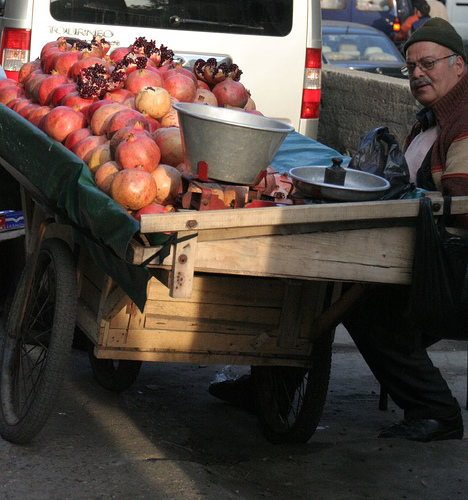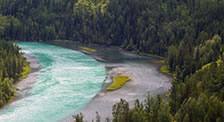Evolution of Xinjiang Tourism: A Photo Essay
One of my favorite tourist spots in Xinjiang is changing. Like Kanas Lake, Heavenly Lake, and Kashgar’s Old City – all beautiful gems of Xinjiang travel that have been swallowed up by tourism – the ancient city of Jiaohe in Turpan is being exploited, and it makes me sad.
I realize that this isn’t a Chinese problem. Tourism has this same effect all across the globe. I’m just a little disappointed to see it happening here in my backyard, in one of my favorite cities in China.
Click to see a video of Turpan’s Jiaohe City here…
Below is a short set of photos that will take you through the evolution of tourism at Turpan’s Jiaohe Ancient City.
For those of you who might not know, Turpan is an ancient desert oasis that became an important stop along the old Silk Road. It was at one point the capital of the region until it was abandoned in the early 13th century.
The mud-built city, situated on a plateau between two rivers, has been well-preserved thanks to Turpan’s extremely dry climate and features residential areas, government offices, temples and burial sites. It truly is a blast to visit.
Changes in the way tourist visit Jiaohe are coming soon, but I find it interesting to note what changes have already taken place over the past couple decades.
1980s to early 1990s
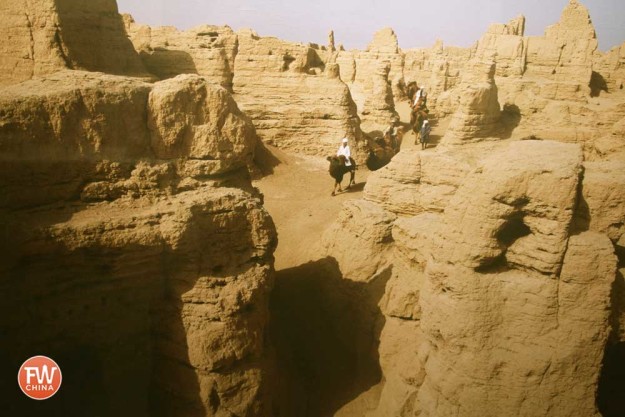
Photo part of the Turpan Museum collection
In the early 1990s, visitors would drive from Turpan city along a dirt road for almost half an hour before reaching Jiaohe. Upon arrival, camels would provide passage through the ancient sandy streets, likely one of the primary routes of transportation during the time the city was actually inhabited.
1990s to early 2000s
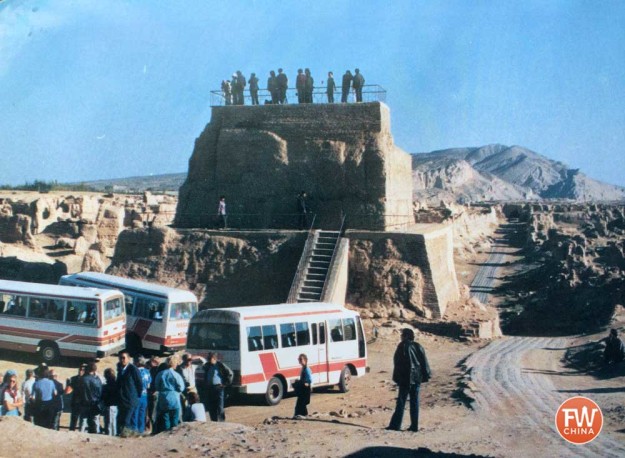
Once authorities realized the money-making potential of Jiaohe, a number of changes were made to the ancient city to make it more accessible. Streets were widened, brick roads were added and staircases were provided to allow guests to climb select structures.
Instead of camels, buses would drive visitors into the heart of the city where an old temple was used as a viewing deck. Very little oversight meant that visitors could do pretty much whatever they wanted or climb on whatever structure they wanted.
Mid-2000s
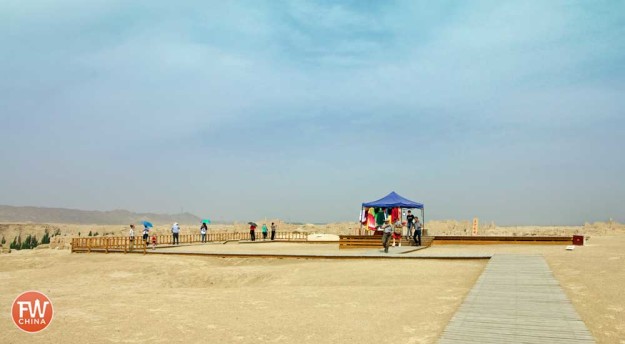
In the late 2000s, wooden pathways were built to provide even more direction for visitors. The viewing platform on the old temple was shut down in favor of a new deck located in the center of the city.
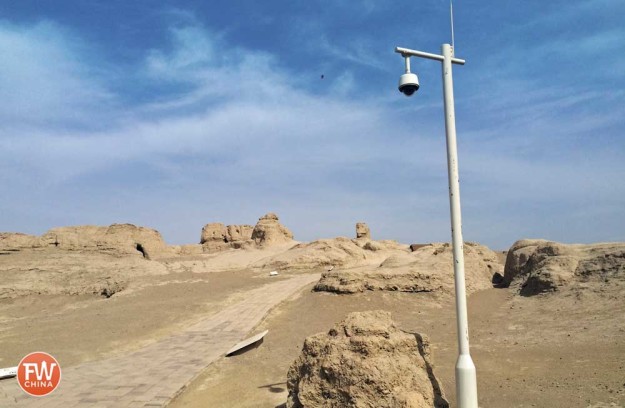
Security cameras were added to make sure that visitors didn’t stray from the paths, which they often did. Should you happen to leave the path, the “Voice of God” will serve a warning (a number of hidden speakers were installed throughout the city as well) and if you persist a staff member will come to escort you out.
Even the hills surrounding Jiaohe have cameras installed to make sure visitors don’t try to get a good birds-eye-view of the city. I’m not entirely sure why they won’t permit this, but again, should you try to climb the nearby hill, a man on a motorcycle will come driving up to escort you away.
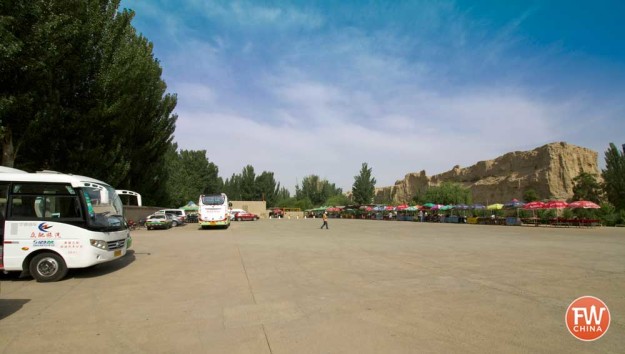
As of 2015, a parking lot at the foot of the Jiaohe entrance is where visitors park their car or get off their bus. Vendors selling hats, water, ice cream and Mao memorabilia (notice not a single Jiaohe souvenir) line up near the entrance.
In 2014 the price to enter was 40 RMB (US$6.50). In 2015 the price to enter is 70 RMB (US$11). In 2016 that price is expected to double, because …
The Future of Jiaohe
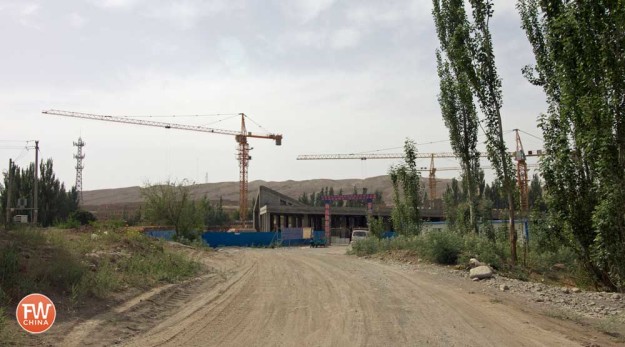
… a new tourism and ticket center is being built about half a mile southeast of the city.
Once completed, tourists will have to stop here to buy their tickets and then hop on a mandatory shuttle running the half mile to Jiaohe. On its way, the shuttle will likely stop at an “Ancient Uyghur Village” (interestingly built only 8 years ago) before dropping visitors off at a vendor-infested entrance.
Needless to say, if you have a chance to visit Jiaohe in Turpan before next year…DO IT! Grab a copy of the FarWestChina Xinjiang travel guide and make your way out here soon before these and many other changes go into effect.
My Soapbox on Tourism in China
Forgive me, but I have to take a moment to vent my frustration here.
Tourism all over the world is a double-edged sword, I realize. On one hand it can provide much-needed money for preservation while on the other hand it can completely suck the life out of a destination if not kept in check.
As recently as a decade ago, foreigners fueled the tourism industry here in Xinjiang. We loved the Uyghur culture and the adventure of trekking through mostly uncharted territory. For the most part, we didn’t mind the dirt roads or the rough accommodation, since that was what we came to experience.
In an effort to reach Xinjiang, they ended up transforming it.”
At some point in the 2000s, however, China’s tourism machine discovered Xinjiang. Tourist groups from all over China began to head west, and these groups expected more than what was already being offered. For this reason, roads were paved, massive ticket booths were built, and monstrous 5-star hotels were constructed.
In an effort to reach Xinjiang, they ended up transforming it.
The good news is that Xinjiang is more accessible than ever. Whether you prefer a cheap hostel or a luxurious hotel, the region is being set up to accommodate both. This also means that much of the charm that made Xinjiang special is being slowly drained away.
Like I said, it’s a double-edged sword that, at least for the moment, is making me quite unhappy.

